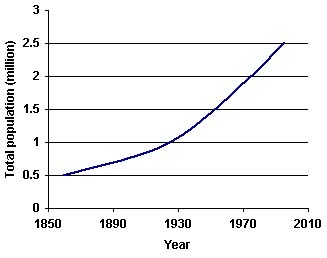 |
| back
to data |
|
|
People living
on island-countries, such as Jamaica, rely on coral reefs for protection
and livelihood. The reef structure protects adjacent atolls, islands and
mainland areas from erosion and wave damage generated by storms and tsunamis.
Coral reefs form popular vacation islands. To the local people, reefs
are an important source of income (via artisanal fishing and tourism)
and daily nutritional needs (fish is a high source of protein).
(Margulis
and Schwartz, 1998; Hoegh-Guldberg, 1999)
|
 |
Here
is a figure showing the exponential population growth in Jamaica
from 1860s to 1995. This exponential growth is projected to
persist until 2010.
- How
do you think the exponential growth in the human population
of this island-country impact the marine ecosystem?
- The
increasing population has been implicated as contributing
significantly to the overfishing of Jamaica's coral reef
resources.
- How
can this happen?
- Could
it have been avoided? How?
|
| (Figure
modified from data presented in Hughes,
1994) |
|
|
 |
|
|
Most
of the fishing taking place in Jamaican coral reefs is artisanal
in nature. This means that the fish caught by these Jamaican
fishers are intended for direct consumption by the fisher
or used as a source of income. The harvests are destined for
domestic consumption as fresh fish via restaurants or fish
markets.
There
has been a steady increase in the number of registered fishermen
since easy access to the reefs allow for a source of food
and income.
|
TARGET
SPECIES & METHOD
Jamaican
fishers generally target a wide range of marine species, including
bottom-dwelling, coral reef species and semi-pelagic species
of finfish. Lobsters, marine shrimp, conch, crab, oysters,
and other marine invertebrates are harvested as well.
The fishing is traditionally conducted from canoes with use
of nets, spears, lines, traps, and diving. Some canoes are
powered by outboard engines. Fishing by more than one method
is quite common.
|
| Table
1. Estimated total fishing yield and use of canoes
in Jamaica (1968 to 1981). |
| |
Total
yield |
Canoes
fishing the area |
catch
per canoe |
| 1968 |
5840
t
|
0.33
canoes/km^2
|
4.23
t
|
| 1973 |
6611
t
|
0.46
canoes/km^2
|
3.46
t
|
| 1981 |
6757
t
|
0.65
canoes/km^2
|
2.49
t
|
|
This
table compares total fishing yield with the amount of effort
required for the landings. Effort is measured via the number
of canoes used and the amount of catch per canoe. Total
yield increased from 1968 to 1981. However, the number of
canoes doubled per unit area and the catch per canoe decreased
as well.
-
What
does this suggest about the health of the fish population,
i.e. availability of fish, in Jamaica?
- What
do you think will happen if this fishing pattern continues?
- What
could be causing the increased fishing effort?
|
The
Status of Coral Reefs of the World: 2000 reports the
status on the following components of the Jamaican coral reefs:
|
Reported
status |
| Reef
fish |
- All
large species & most predators are absent
of very scarce, which has led to increasing
loss of herbivorous fish as fishing persists.
- The
main target species remaining on reefs are herbivorous
fish such as small parrotfish & surgeonfish.
|
| Fisheries |
- Artisanal
fishery operations take place in over 200 fishing
beaches around the island.
- Antillean
z-trap, nets, lines, and spears are principal
fishing gear.
- There
has been a marked decline in catch-per-unit-effort
since early 1960s.
- The
decline in fish catch has been accompanied by
a decrease in fish size and quality.
|
| Corals |
- Coral
population has decreased to less than 5% at
many locations.
- Slight
increases of coral cover in Discovery Bay and
some north coast location.
- Porites
asteroides, P. porites, and Agaricia
agaricites are the growing coral populations,
instead of the original frame-builders like
Acropora.
|
|
|
| |
|
|
|
|
 |
|
|
Jamaica
is a part of the Sustainable Development Network Programme
(SDNP) launched by the United Nations Development Programme
(UNDP) to help developing countries establish and maintain
their tourism industry.
Jamaica's economy has become increasingly dependent on tourism.
Increased marketing efforts by the Jamaica Tourist Board has
resulted in Jamaica being recognized as a preferred tourism
destination. The following achievements establishes the tourism
in Jamaica in an advanced stage of development:
-
In 1992 direct, indirect, and induced employment in the
tourism sector totalled 217,000 full-time equivalent jobs
or 23 percent of the employed labour force.
- In
1992 tourism accounted for 13.3 percent of Jamaica's total
gross domestic product.
- The
number of rooms totalled 20,896 in December 1995 as against
10,776 in December 1990.
- The
number of visitors in the period January to December 1996
was 1,820,627 up 3.0% compared with 1995, with earnings
for the sector amounting to US$1.1 billion for that same
period.
|
ECOLOGICAL
IMPACT
The
Status of Coral Reefs of the World: 2000 reports the
rapid growth of facilities for coastal tourism has contributed
to increased terrestrial runoff. This runoff transports suspended
sediment, sewage pollution, and excess nutrients directly
into the coastal environment.
- How
do you think the tourism industry can impact the coral reefs?
- What
should Jamaica do about the ecological impacts due to the
growing tourism industry?
|
| |
(Woodley
et al, 2000; www.jsdnp.org.jm/susTourism-status.htm)
|
|
| back
to data |
|
| |
|
This web
site was created by Lynn Tran at the North Carolina State University, Department
of Mathematics, Science, and Technology Education on 7/12/03. Faculty advisor
Dr. David Eggleston, NCSU, Department of Marine, Earth, & Atmospheric Sciences.
Last updated
December 29, 2003
.
|
